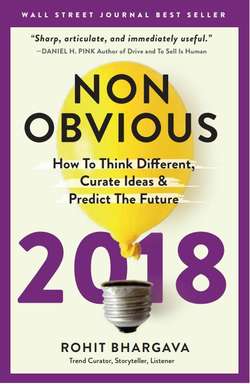Читать книгу Non-Obvious 2018 Edition - Рохит Бхаргава - Страница 63
На сайте Литреса книга снята с продажи.
Step 5—Proving
ОглавлениеProving is the final step where you evaluate your ideas, seek
out more research where needed and make a case for why an
idea describes the accelerating present.
Photo Credit: Tech.co (Tech Cocktail Sessions DC)
Though my Haystack Method relies heavily on analyzing stories and ideas that have been published, there is also a consistent thread of conversations, speeches, and interviews that inform the trend spotting process. I’m lucky to be able to speak at fifty or so events every year, and my team and I routinely deliver dozens of workshops at companies in almost every industry.
The result of these interactions is a consistent stream of ideas as well as the opportunity to interview the visionary keynote speakers I’m sharing the stage with, which allows me to test new trend ideas and approaches with some of these groups before publishing the new trends..
I believe that trends are curated based on observing behavior, identifying patterns, and assembling the pieces of a puzzle. You can’t make a puzzle by showing someone a piece and surveying them about what they think the rest of the puzzle might be.
I don’t mean to discount the value of focus groups or surveys as input. The truth is, the more analytical or scientific your stakeholders and audience, the more likely it is you’ll need some of this type of data to support your curated trends. But I’m neither a behavioral psychologist nor a market researcher. There are people who are excellent at this, and I would much rather read that research and have a conversation with them—and then use those insights to inform my curation of trends and help to prove them in this final phase of the Haystack Method.
The framework my team and I use, and teach our clients to use, to prove ideas is based on a formula of looking at three critical elements: idea, impact, and acceleration.
